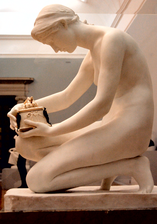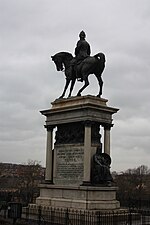Harry Bates (sculptor)
This article needs additional citations for verification. (January 2009) |
Harry Bates | |
|---|---|
 | |
| Born | 26 April 1850 |
| Died | 30 January 1899 (aged 48) London |
| Nationality | British |
| Known for | Sculpture |
| Awards | Royal Academy |
Harry Bates ARA (26 April 1850 – 30 January 1899) was a British sculptor. He was elected to the Royal Academy in 1892 as A.R.A. and was an active, if intermittent, member of the Art Workers Guild. He was a central figure in the British movement known as New Sculpture.
Biography
Bates was born on 26 April 1850 in Stevenage in Hertfordshire. He began his career as a carver's assistant, and before beginning the regular study of plastic art he passed through a long apprenticeship in architectural decoration working from 1869 for the firm of Farmer & Brindley.
In 1879 he went to London and entered the South London School of Technical Art (formerly known as Lambeth School of Art, now the City and Guilds of London Art School). There he studied under Jules Dalou[2] and won a silver medal in the national competition at South Kensington. In 1881, he was admitted to the Royal Academy schools, where in 1883 he won the gold medal and the travelling scholarship with his relief of Socrates teaching the People in the Agora, which showed grace of line and harmony of composition. He immediately went to Paris, where he took up an independent studio (on Dalou's suggestion) in 1883–85. He was influenced by Rodin, who advised him on occasion about his work. A head and three small bronze panels (the Aeneid), executed by Bates in Paris, were exhibited at the Royal Academy, and selected for purchase by the Chantrey Bequest trustees; but the selection had to be cancelled because they had not been modelled in Britain.[3]
Bates returned to Britain in 1886, and was elected to the Art Workers Guild.

His Aeneas (1885), Homer (1886), three Psyche panels and Rhodope (1887), all showed marked advance in form and dignity. Bates's primary skill lay in the composition and sculpting of relief sculpture, and it is in this medium that he achieved his most technically and aesthetically refined work. The freestanding ideal sculpture remained the most important of sculptural genres, however, and Bates gradually turned to statues such as the 1889 Hounds in Leash, which is essentially a relief composition translated to three dimensions. In this work, Bates demonstrated his ability to convey muscular intensity and movement and led to his greater success and ambition.
His next major statue, the 1890 Pandora, is more truly a figure in the round, and in this work Bates experimented with polychromy and mixed materials, making it self-consciously into a paradigmatic example of his artistic priorities. The box she holds is an actual decorative casket made of ivory and gilt bronze and elaborately carved with scenes from the Pandora legend. It was exhibited in 1890 at the Royal Academy Summer Exhibition and purchased within the following year for the Chantrey Bequest.[3]
One of his final commissions was a large bronze statue of Queen Victoria unveiled in Albert Square in Dundee shortly after his death.[4]
He died on 30 January 1899 at his residence, 10 Hall Road, St. John's Wood, N.W. He was buried at Stevenage on 4 February.[3]
Assessment
The portrait-busts of Harry Bates are good pieces of realism: strong, yet delicate in technique, and excellent in character. His statues have a picturesqueness in which the refinement of the sculptor is always felt. Among the chief of these are the fanciful Maharaja of Mysore, somewhat overladen with ornament, and the colossal equestrian statue of Lord Roberts (1896) upon its important pedestal, girdled with a frieze of figures, now set up in Calcutta, and a statue of Queen Victoria for Dundee. But perhaps his masterpiece—in which his interest in polychromy and mixed materials in a format that fused decorative art and sculpture achieved its fullest realization—was an allegorical presentment of Love and Life, a winged male figure in bronze, with a female figure in ivory being crowned by the male.[5]
Bates died in London on 30 January 1899, his premature death robbing English plastic art of its most promising representative at the time.[5] He is primarily remembered as one of the most important sculptors working with the traditions of the decorative arts within the New Sculpture movement. Both through his innovative use of polychromy and his allusive subject matter, he is often understood to be one of primary representatives of international Symbolism within British sculpture.[citation needed]
Gallery
-
Boys with Coat of Arms, Moorgate Place Entrance of Chartered Accountants' Hall
-
Relief of Psyche, Mougins Museum of Classical Art
References
- ^ American Art Annual, Volume 2. American Federation of Arts. 1899. p. 82.
- ^ City and Guilds of London Art School History Archived 4 October 2011 at the Wayback Machine
- ^ a b c Radford 1901.
- ^ "Statue of Queen Victoria | Yale Center For British Art".
- ^ a b Chisholm 1911.
- ^ Encyclopædia Britannica, ed. 1911, vol. 24, pg. 504, Plate III.
- Attribution
- This article incorporates text from a publication now in the public domain: Chisholm, Hugh, ed. (1911). "Bates, Harry". Encyclopædia Britannica. Vol. 3 (11th ed.). Cambridge University Press. p. 509.
 This article incorporates text from a publication now in the public domain: Radford, Ernest (1901). "Bates, Harry". In Lee, Sidney (ed.). Dictionary of National Biography (1st supplement). Vol. 1. London: Smith, Elder & Co. pp. 140–141.
This article incorporates text from a publication now in the public domain: Radford, Ernest (1901). "Bates, Harry". In Lee, Sidney (ed.). Dictionary of National Biography (1st supplement). Vol. 1. London: Smith, Elder & Co. pp. 140–141.
Further reading
- Beattie, Susan. The New Sculpture. New Haven: Yale University Press, 1983.
- Getsy, David. "Privileging the Object of Sculpture: Actuality and Harry Bates's Pandora of 1890." Art History 28.1 (February 2005): 74–95.
- Read, Benedict. Victorian Sculpture. New Haven: Yale University Press, 1982.
- Wilton, Andrew and Robert Upstone. The Age of Rossetti, Burne-Jones, and Watts: Symbolism in Britain. Exh. cat., Tate Gallery, 1997. Paris: Flammarion, 1997.
External links
- The Victorian Web
- Tate Britain: rare Victorian sculpture - set by ketrin1407 on Flickr featuring numerous views of Bates' Pandora among others
- Profile on Royal Academy of Arts Collections





![Sculpture of Homer, 1886[6]](http://upload.wikimedia.org/wikipedia/commons/thumb/3/3c/EB1911_Plate_III._v24%2C_pg.504%2C_Fig_4.jpg/523px-EB1911_Plate_III._v24%2C_pg.504%2C_Fig_4.jpg)
